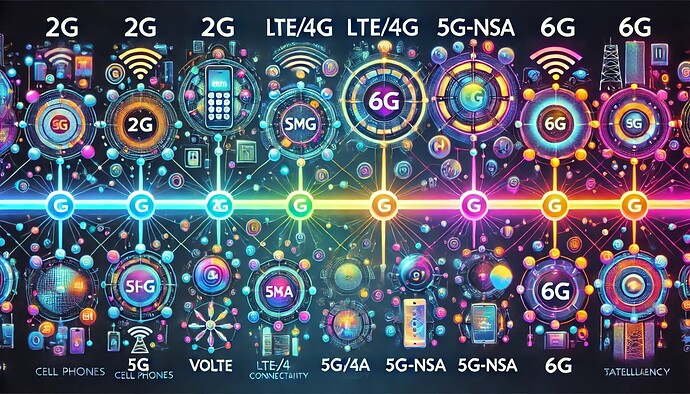Network Architecture
- 2G (GSM): Circuit-switched (CS) architecture
- LTE (4G): Packet-switched (PS) architecture
- VoLTE: Packet-switched over LTE with IMS integration
- 5G-SA: Fully 5G core and access with a service-based architecture
- 5G-NSA: LTE EPC core with support for 5G NR (dual connectivity)
- 6G (Future): Unified terrestrial and Non-Terrestrial Networks (NTN)
Voice
- 2G (GSM): Circuit-switched voice services
- LTE (4G): Optional VoIP support via IMS for voice calls
- VoLTE: Voice over IMS with high QoS for voice and video calls
- 5G-SA: Voice over IMS or custom methods with ultra-low latency
- 5G-NSA: VoLTE for voice over LTE anchor
- 6G (Future): Immersive communication with advanced codecs and holography
Signaling
- 2G (GSM): SS7 for circuit-switched signaling
- LTE (4G): SIP-based signaling over IP for voice and data
- VoLTE: SIP over IMS with QoS bearers for voice
- 5G-SA: SIP over IMS for voice and data signaling
- 5G-NSA: SIP over IMS via LTE anchor
- 6G (Future): AI/ML-based adaptive signaling mechanisms
Bearer
- 2G (GSM): No bearer concept; uses circuit-switched connections
- LTE (4G): Default and dedicated packet-switched bearers
- VoLTE: Dedicated QoS bearer for voice traffic
- 5G-SA: QoS flows via 5G NR and User Plane Function (UPF)
- 5G-NSA: LTE EPC manages bearers, 5G NR enhances data
- 6G (Future): Dynamic, intent-based network slicing and bearers
Latency
- 2G (GSM): High latency (~200 ms)
- LTE (4G): Moderate latency (~50 ms)
- VoLTE: Low latency (~30 ms)
- 5G-SA: Ultra-low latency (~1 ms)
- 5G-NSA: Low latency (~10–15 ms)
- 6G (Future): Ultra-ultra-low latency (<1 ms)
Handover
- 2G (GSM): Hard handover with interruptions
- LTE (4G): Seamless handovers using S1/X2
- VoLTE: Seamless handovers with QoS continuity
- 5G-SA: Seamless handovers across 5G cells
- 5G-NSA: Handover between LTE and 5G NR paths
- 6G (Future): Seamless global handovers using AI-based mechanisms
Bandwidth
- 2G (GSM): Narrowband (~200 kHz channels)
- LTE (4G): Wideband (~20 MHz per carrier)
- VoLTE: Same bandwidth as LTE, optimized for voice
- 5G-SA: Much higher bandwidth (>100 MHz per carrier)
- 5G-NSA: Enhanced bandwidth using 5G NR (~50–100 MHz)
- 6G (Future): Terahertz spectrum (>1 GHz) for extreme data rates
Use Case
- 2G (GSM): Basic voice and SMS communication
- LTE (4G): High-speed data services and OTT apps
- VoLTE: High-quality voice and video calling over LTE
- 5G-SA: Data-intensive, mission-critical, IoT, and industrial applications
- 5G-NSA: Data and improved throughput over LTE and 5G
- 6G (Future): Holograms, AI-driven applications, and immersive experiences
Core
- 2G (GSM): MSC/VLR/HLR-based circuit core
- LTE (4G): EPC (Evolved Packet Core)
- VoLTE: EPC with IMS for voice and video services
- 5G-SA: Service-Based Architecture (SBA) in the 5G Core (5GC)
- 5G-NSA: EPC with LTE anchor and 5G NR enhancements
- 6G (Future): Decentralized, AI-enhanced network cores
LinkedIn: ![]()
